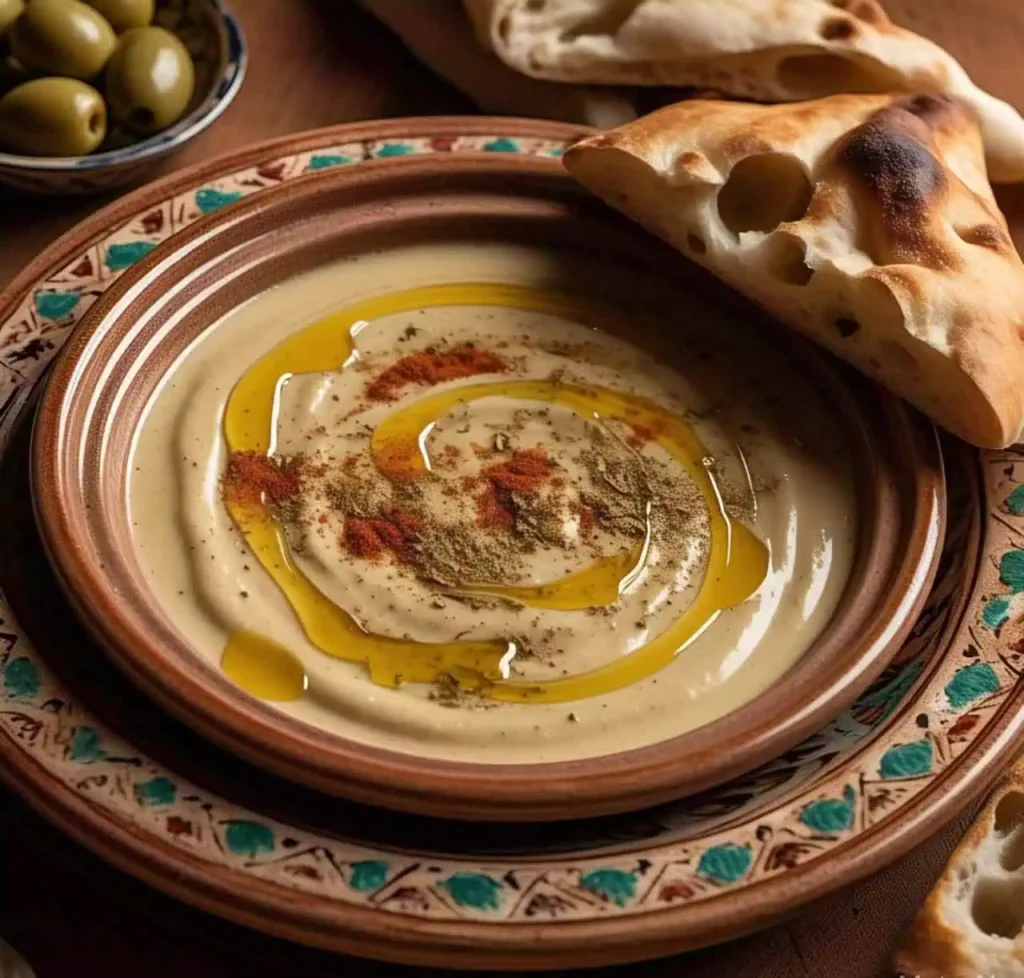Bisara is a simple yet hearty North African soup made from pureed fava beans (or split peas), olive oil, and spices. This creamy dish is a staple in Moroccan, Algerian, and Egyptian cuisines, often enjoyed as a warm breakfast, lunch, or comforting winter meal.
With its rich flavor, smooth texture, and high nutritional value, Bissara is a budget-friendly, protein-packed dish that has been enjoyed for centuries.
Table of Contents
What is Bisara?
Bissara is a pureed bean soup that is:
- Made with dried fava beans or split peas, cooked until soft and blended.
- Seasoned with garlic, cumin, paprika, and olive oil for a rich depth of flavor.
- Often garnished with extra virgin olive oil, lemon juice, and fresh herbs.
Why this dish is Popular in North Africa
- Affordable & Nutritious: A simple dish that is high in protein, fiber, and essential vitamins.
- Easy to Make: Requires minimal ingredients and preparation, making it a favorite for busy households.
- A Winter Staple: Served warm, Bissara is a comforting and filling dish perfect for cold weather.
- Traditional Street Food: In Morocco, Bissara is often sold by street vendors in small bowls, served with bread and olive oil.
The History and Cultural Significance of Bisara
Bisara is a centuries-old dish with roots in North African and Middle Eastern cuisine. While its origins are primarily linked to Egyptian and Moroccan culinary traditions, variations of this dish are found in different regions across the Arab world.
1. The Origins of Bisara
The name “Bisara” is believed to have originated from the Pharaonic era, where Egyptians consumed pureed legumes as a staple food. Over time, the dish spread to North Africa and the Levant, evolving with regional ingredients and spices.
- Ancient Egyptian Influence: Early versions of this dish were made with broad beans and herbs, served as a nourishing meal for laborers.
- North African Adaptations: Moroccan Bisara is often made with split peas or fava beans, featuring cumin and olive oil.
- Middle Eastern Variations: Some variations include lentils or chickpeas, giving the dish a different texture and taste.
2. How this dish Became a Comfort Food
Bisara has remained popular for generations due to its affordable ingredients, simplicity, and nutritional benefits.
- A Dish for the Common People: Historically, Bisara was considered a “poor man’s dish” because it was made with cheap, locally available legumes.
- A Winter Essential: Many North African households prepare warm Bisara during cold months to provide energy and nourishment.
- A Symbol of Tradition: this dish continues to be passed down through families, with each generation adding its own unique touch.
Fact: In Morocco, This dish is often served for breakfast or lunch with hot tea and crusty bread.
From ancient Egyptian roots to its modern-day variations across North Africa, Bisara remains a beloved dish that represents tradition, comfort, and nutrition.
Health Benefits
Bisara is a nutrient-dense dish, packed with protein, fiber, vitamins, and antioxidants. Made primarily from fava beans or split peas, this hearty soup supports digestion, heart health, and sustained energy levels.
1. Nutritional Breakdown of Fava Beans
Fava beans (broad beans) are the primary ingredient in traditional Bisara. Below is a nutritional breakdown per serving (1 cup of cooked fava beans):
| Nutrient | Amount | Health Benefits |
|---|---|---|
| Calories | ~180 kcal | Provides energy and sustains fullness |
| Protein | 13g | Builds and repairs muscles |
| Fiber | 9g | Aids digestion and promotes gut health |
| Iron | 14% DV | Supports red blood cell production |
| Magnesium | 20% DV | Helps with muscle and nerve function |
| Vitamin C | 10% DV | Boosts immunity and skin health |
| Folate (Vitamin B9) | 40% DV | Essential for brain health and cell growth |
Tip: Adding a squeeze of lemon juice before serving enhances iron absorption from the fava beans.
2. How this dish Supports Digestion and Energy Levels
Bisara is easy to digest and provides long-lasting energy, making it an excellent meal for breakfast or lunch.
How Bisara Aids Digestion:
- High fiber content promotes healthy digestion and prevents constipation.
- Fava beans and cumin help reduce bloating and support gut health.
- Olive oil adds healthy fats that aid nutrient absorption.
How Bisara Provides Energy:
- Complex carbohydrates in fava beans provide sustained energy without causing sugar spikes.
- Protein-rich legumes keep you full longer, preventing hunger between meals.
- Iron and magnesium support oxygen transport and muscle function, reducing fatigue.
Tip: For extra energy, pair Bisara with whole wheat bread or flatbread.
3. Bisara as a High-Protein and Fiber-Rich Meal
Bisara is an excellent plant-based source of protein, making it ideal for vegetarians and vegans.
Why Bisara is a Great Protein Source:
- Fava beans contain all essential amino acids, making them a complete protein.
- A high-protein diet supports muscle growth and weight management.
Why Bisara is High in Fiber:
- Keeps digestion regular and supports gut microbiome health.
- Helps regulate blood sugar levels by slowing down glucose absorption.
- Supports heart health by lowering cholesterol levels.
Tip: For extra protein, add a drizzle of tahini or a boiled egg on top of your Bisara.
Health Benefits of Fava Beans: www.medicalnewstoday.com
Essential Ingredients for Bisara
1. Choosing the Right Type of Beans
The main ingredient in Bisara is dried fava beans (broad beans) or, in some variations, split peas.
Best Options for Bisara:
- Dried fava beans (peeled or unpeeled):
- Peeled fava beans result in a smoother, creamier texture.
- Unpeeled fava beans add more fiber but require longer cooking and blending.
- Split peas (yellow or green):
- A common alternative, especially in Moroccan versions.
- Produces a lighter, slightly sweeter taste.
Tip: If using whole fava beans, soak them overnight to reduce cooking time and improve digestion.
2. The Role of Garlic, Cumin, and Olive Oil
Garlic:
- Provides a bold, aromatic flavor and enhances the dish’s earthy taste.
- Known for anti-inflammatory and immune-boosting properties.
- Can be sautéed before blending for a milder taste or added raw for extra sharpness.

Cumin:
- Adds a distinct warm, nutty flavor, which is essential in both Moroccan and Egyptian Bisara.
- Helps with digestion and bloating.
Olive Oil:
- A key ingredient for richness and depth.
- Drizzled on top before serving to enhance flavor.
- Provides healthy monounsaturated fats for heart health.
Tip: Use extra virgin olive oil for the best taste and nutritional benefits.
3. Optional Ingredients for Extra Flavor
To customize the flavor profile, you can add:
Spices & Seasonings:
- Paprika – Adds mild sweetness and warmth.
- Coriander – Enhances freshness and balances the dish.
- Red Pepper Flakes or Harissa – For a spicy kick.
Toppings & Garnishes:
- Fresh parsley or cilantro – Adds brightness and color.
- Fried onions – Traditional in Egyptian Bisara for extra texture.
- Lemon juice – Enhances freshness and boosts iron absorption.
Tip: Garnish Bisara with toasted cumin seeds for extra fragrance and depth.
How to Make Traditional Bisara
1. Cooking Methods: Stovetop and Pressure Cooker
Bisara can be cooked using two methods, depending on time and convenience.
Stovetop Method (Traditional & Best for Flavor Development)
- Requires slow simmering for 40–50 minutes.
- Produces a rich and deeply infused flavor.
Pressure Cooker / Instant Pot Method (Fastest Option)
- Cuts cooking time to 15–20 minutes.
- Best for quick meal prep while maintaining flavor.
Tip: The stovetop method enhances depth of flavor, but the pressure cooker is great when you’re short on time.
2. Step-by-Step Bisara Recipe
Ingredients:
Base Ingredients:
- 2 cups dried fava beans (or split peas), soaked overnight
- 4 cups water or vegetable broth
- 3 cloves garlic, minced
- 1 tsp ground cumin
- ½ tsp paprika (optional for extra warmth)
- ½ tsp salt (or to taste)
- ¼ cup extra virgin olive oil
Optional Garnishes:
- 1 tbsp fresh parsley or cilantro, chopped
- ½ tsp red pepper flakes (for a spicy kick)
- Fried onions (for an Egyptian-style topping)
- 1 tbsp lemon juice (for extra freshness)
Step 1: Cook the Beans
- Rinse and drain the soaked fava beans or split peas.
- In a large pot, add the beans and 4 cups of water or vegetable broth.
- Bring to a boil, then reduce heat to low and let simmer for 40–50 minutes (or 15–20 minutes in a pressure cooker) until the beans are soft.
Tip: Skim off any foam that forms during boiling for a smoother texture.
Step 2: Blend the Bisara
- Once the beans are fully cooked and tender, remove from heat.
- Use an immersion blender or regular blender to puree the soup until smooth and creamy.
- Stir in garlic, cumin, paprika, and salt, mixing well.
Tip: For a thicker Bisara, simmer for an additional 5–10 minutes after blending.

Step 3: Final Seasoning & Garnishing
- Drizzle with olive oil and stir to incorporate its rich flavor.
- Serve hot, garnished with fresh parsley, red pepper flakes, and a squeeze of lemon juice.
- For an Egyptian-style Bisara, top with crispy fried onions before serving.
Tip: Pair with warm pita bread, Moroccan khobz, or whole wheat flatbread for the best experience.
3. Tips for Achieving the Perfect Creamy Texture
Balance the Liquid Ratio:
- Too much water? Simmer uncovered for a few extra minutes to thicken.
- Too thick? Add warm water or broth a little at a time.
Enhance the Flavor Depth:
- Toast cumin and paprika in olive oil before adding to boost aroma.
- Use vegetable broth instead of water for extra richness.
For a Richer Texture:
- Add a tablespoon of tahini or yogurt for extra creaminess.
Variations of Bisara
While traditional Bisara is made with fava beans or split peas, garlic, and cumin, different regions have their own unique twists on the dish.
1. Moroccan Bisara vs. Egyptian Bisara
The two most popular versions of Bisara come from Morocco and Egypt, but they differ in texture, serving style, and seasonings.
Moroccan Bisara:
- Made with dried fava beans or split peas.
- Thinner, soup-like consistency, served warm.
- Seasoned with cumin, olive oil, paprika, and sometimes harissa.
- Typically eaten for breakfast or lunch, paired with Moroccan bread (khobz).
Egyptian Bisara:
- Made with fava beans and sometimes split peas.
- Thicker, dip-like consistency, similar to hummus.
- Blended with onions, coriander, and fresh herbs for a rich, aromatic taste.
- Often topped with crispy fried onions and served with pita bread.
Tip: If you prefer a heartier meal, try the Egyptian version. If you enjoy soups, go for the Moroccan version.
2. Spicy Harissa Bisara
For those who love heat and bold flavors, adding harissa or chili flakes transforms Bisara into a spicy, smoky delight.
How to Make a Spicy Version:
- Stir in 1 tbsp harissa paste after blending for a North African twist.
- Add ½ tsp red pepper flakes or cayenne pepper for extra heat.
- Garnish with chili-infused olive oil for a fiery finish.
Tip: Pair spicy Bisara with cooling sides like yogurt or cucumber salad to balance the heat.
3. Split Pea Alternative
If fava beans are unavailable, yellow or green split peas make a fantastic alternative.
Why Use Split Peas?
- Faster cooking time (no overnight soaking required).
- Sweeter, milder taste compared to fava beans.
- Same creamy texture when blended.
Tip: Green split peas have an earthier flavor, while yellow split peas are slightly sweeter.
4. Other Creative Bisara Variations
For a Creamier Texture:
- Blend in a tablespoon of tahini for a richer, nuttier flavor.
- Stir in Greek yogurt or coconut milk for extra silkiness.
For Extra Protein:
- Add a poached egg or shredded chicken on top.
- Mix in lentils or chickpeas for a multi-legume Bisara.
For a Smoky Flavor:
- Roast the garlic before blending.
- Sprinkle smoked paprika or add a dash of liquid smoke.
serving and storing bisara
1. Best Ways to Serve and Pair this dish
- Traditional Side Dishes & Breads:
- Served with Moroccan khobz, pita bread, or whole wheat flatbread.
- Pairs well with grilled vegetables or pickled olives.
2. Best Drinks to Accompany this dish:
- Mint tea (traditional Moroccan pairing).
- Lemon-infused water to enhance digestion.
- Warm milk or yogurt-based drinks for a creamy balance.
3. How to Present this dish for Guests:
- Serve in a deep bowl, drizzled with olive oil and fresh herbs.
- Garnish with paprika, cumin, or fried onions for visual appeal.

2. Storing and Reheating Bisara
- Refrigeration: Store in an airtight container for up to 4 days in the fridge.
- Freezing: Freeze in portions for up to 3 months.
- Best Reheating Methods:
- Stovetop: Reheat over low heat, stirring frequently.
- Microwave: Heat in short intervals, adding a bit of water if too thick.
3. Common Mistakes to Avoid When Making this dish
- Overcooking or Undercooking the Beans: Cook until soft for easy blending.
- Not Blending the Soup Properly: Use an immersion blender for a creamy texture.
- Skipping the Olive Oil Garnish: Olive oil enhances flavor and richness.
- Using Too Much or Too Little Water: Balance liquid for desired thickness.
- Not Seasoning Well Enough: Adjust salt, cumin, and lemon juice to taste.
Frequently Asked Questions About Bisara
Can I Use Split Peas Instead of Fava Beans?
- Yes! Split peas offer a similar creamy texture and faster cooking time.
What’s the Best Way to Make a Spicy Version?
- Add harissa, red pepper flakes, or cayenne pepper.
How Do I Make this dish Thicker?
- Simmer longer after blending or use less water while cooking.
Is Bisara Gluten-Free?
- Yes, as long as it’s served without bread containing gluten.
Can I Add Extra Vegetables to the Soup?
- Yes! Carrots, onions, or zucchini add extra nutrients.
Bisara (Moroccan Fava Bean Soup)
Equipment
- Large pot
- Immersion blender or regular blender
- Knife
- Cutting board
- Ladle
Ingredients
Base Ingredients
- 2 cups dried fava beans Or split peas, soaked overnight.
- 4 cups water or vegetable broth For cooking the beans.
- 3 cloves garlic Minced.
- 1 tsp ground cumin For warmth and depth of flavor.
- ½ tsp paprika Optional, for extra warmth.
- ½ tsp salt Or to taste.
- ¼ cup extra virgin olive oil For richness and flavor.
Optional Garnishes
- 1 tbsp fresh parsley or cilantro Chopped, for garnish.
- ½ tsp red pepper flakes For a spicy kick.
- fried onions For an Egyptian-style topping.
- 1 tbsp lemon juice For extra freshness.
Instructions
- Rinse and drain the soaked fava beans or split peas.
- In a large pot, add the beans and 4 cups of water or vegetable broth.
- Bring to a boil, then reduce heat to low and let simmer for 40–50 minutes (or 15–20 minutes in a pressure cooker) until the beans are soft.
- Skim off any foam that forms during boiling for a smoother texture.
- Once the beans are fully cooked and tender, remove from heat.
- Use an immersion blender or regular blender to puree the soup until smooth and creamy.
- Stir in garlic, cumin, paprika, and salt, mixing well.
- For a thicker Bisara, simmer for an additional 5–10 minutes after blending.
- Drizzle with olive oil and stir to incorporate its rich flavor.
- Serve hot, garnished with fresh parsley, red pepper flakes, and a squeeze of lemon juice.
- For an Egyptian-style Bisara, top with crispy fried onions before serving.
Notes
Conclusion
Why You Should Try Making this dish at Home
Bisara is more than just a traditional North African dish—it’s a nutritious, budget-friendly, and comforting meal that has stood the test of time. Whether you’re making the Moroccan soup version or the thicker Egyptian-style dip, this dish is simple to prepare yet deeply flavorful.
Key Takeaways:
- Rich in Nutrients: Packed with protein, fiber, and essential vitamins, making it a healthy and satisfying meal.
- Versatile & Customizable: Easily adapted with different legumes, spices, and toppings to suit your taste.
- Perfect for Any Meal: Can be served as a breakfast, lunch, or dinner, paired with bread, tea, or salads.
- Great for Meal Prep: Stores well in the fridge or freezer, making it a convenient make-ahead meal.
- Authentic & Comforting: A warming, creamy dish that brings a taste of North African tradition to your kitchen
Whether you’re looking for a healthy, plant-based meal or want to explore traditional North African cuisine, Bisara is a must-try recipe. Its simplicity, affordability, and deep flavors make it a dish that can be enjoyed by everyone.
For more Moroccan Recipes to Try
Check out these recipes:
- Amlou: The best Moroccan Almond and Argan Oil Spread Recipe
- 7 Moroccan Couscous Recipes: Authentic Recipes, Variations, and Health Benefits


